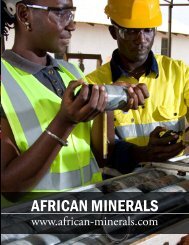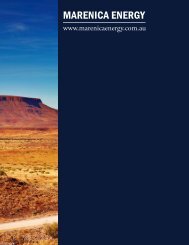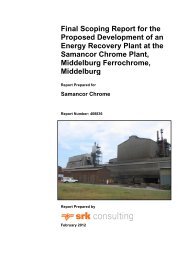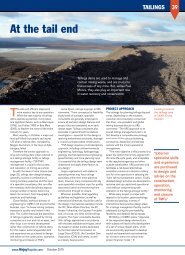Draft Status Quo Report for the Pixley Ka Seme ... - SRK Consulting
Draft Status Quo Report for the Pixley Ka Seme ... - SRK Consulting
Draft Status Quo Report for the Pixley Ka Seme ... - SRK Consulting
You also want an ePaper? Increase the reach of your titles
YUMPU automatically turns print PDFs into web optimized ePapers that Google loves.
<strong>SRK</strong> <strong>Consulting</strong> in association with BKS<br />
<strong>Pixley</strong> <strong>Ka</strong> <strong>Seme</strong> Local Municipality EMF – <strong>Draft</strong> <strong>Status</strong> <strong>Quo</strong> <strong>Report</strong> Page 22<br />
VOCs are both important precursors of photochemical<br />
products.<br />
Rail impacts relate to <strong>the</strong> combustion of diesel fuel by<br />
rail locomotives while transporting loads across rail<br />
networks. The main pollutant of concern with respect to<br />
diesel fuel combustion is diesel particulates, as well as<br />
NOx and CO emissions released to atmosphere.<br />
communities if not controlled. The type and extent to<br />
which <strong>the</strong>se pollutants could impact on local<br />
communities will vary based on <strong>the</strong> composition of <strong>the</strong><br />
waste being treated.<br />
Biomass burning from veld fires occur most frequently<br />
in September. The pollutants of concern generated by<br />
<strong>the</strong>se fires include PM, nitrogen dioxide and CO.<br />
Un-rehabilitated mine tailings impoundments and<br />
active mining works can be considered significant<br />
sources of nuisance dust fallout as well as inhalable<br />
particulate matter (PM). The reclamation of <strong>the</strong>se<br />
tailings impoundments also has a significant impact on<br />
ambient particulate impacts. The proximity of<br />
residential settlements (particularly low income<br />
households) close to <strong>the</strong>se sources is of concern.<br />
Agriculture. PKSLM has numerous farms coupled<br />
with agricultural activities that are responsible <strong>for</strong> <strong>the</strong><br />
release of large quantities of PM, with animal<br />
husbandry often being associated with foul odours.<br />
Industrial and commercial fuel burning, particularly<br />
uncontrolled coal fired boilers in close proximity to<br />
residential areas can be of concern. These can be<br />
associated with schools, light industrial areas and<br />
hospitals, etc. These sources contribute significantly to<br />
ambient sulphur dioxide and particulate matter 10<br />
microns or less (PM 10 ) concentrations.<br />
Large industries operating in <strong>the</strong> area could not be<br />
adequately quantified due to <strong>the</strong> absence of a<br />
comprehensive source and emissions inventory <strong>for</strong> <strong>the</strong><br />
district. Most of <strong>the</strong>se source types release emissions to<br />
<strong>the</strong> atmosphere via dedicated stacks, or via building<br />
fugitives. These emissions may be in both <strong>the</strong> gaseous<br />
and particulate <strong>for</strong>m.<br />
Landfill and incinerator operations are associated<br />
with toxic and odorous gases as well as fugitive dust<br />
emissions. Heavy metal and furan emission from waste<br />
incineration represent a considerable air quality and<br />
health risk.<br />
Sewage works often associated with foul odours, have<br />
little segregation of industrial and domestic waste water<br />
in South Africa. This often results in chemicals which<br />
pose human health risks being treated by municipal<br />
sewage works. The evaporative emissions of <strong>the</strong>se<br />
chemicals can result in health risks to neighbouring<br />
Transboundary pollution. Sources of pollution<br />
situated outside of PKLSM can still impact on <strong>the</strong> air<br />
quality in <strong>the</strong> area. Significant industrial and mining<br />
related sources located north of PKSLM are of<br />
particular concern. Map 6 provides an indication of <strong>the</strong><br />
location and extent to which this may be of significance<br />
to <strong>the</strong> area.<br />
Ambient monitoring and overall assessment<br />
of air quality impacts<br />
Four privately run monitoring stations located in <strong>the</strong><br />
PKSLM are summarised as follows (DEA, 2010):<br />
• Amersfoort: A SASOL operated monitoring station<br />
measuring wea<strong>the</strong>r changes (MET). This monitors<br />
sulphur oxides (SOx), PM and ozone (O 3 );<br />
• Verkykop: An ESKOM operated MET station,<br />
which monitors SOx, PM, O 3 and NOx; and<br />
• Majuba 1 and 2: An ESKOM operated MET<br />
station monitoring SOx and PM.<br />
Results of <strong>the</strong> Highveld Air Quality Baselines Study<br />
(DEA, 2010) indicate that PKSLM’s key air quality<br />
issues include biomass burning, household fuel burning,<br />
vehicle use and at a localized scale industrial use<br />
particularly from <strong>the</strong> Majuba power station. The main<br />
pollutants of concern in this region are SOx, with<br />
localized exceedances in <strong>the</strong> vicinity of Majuba power<br />
station, NOx and CO from vehicle emissions, and veld<br />
burning. However, <strong>the</strong> area generally stays within <strong>the</strong><br />
South African ambient standard noted <strong>for</strong> <strong>the</strong>se<br />
pollutants.<br />
3.2.3 Soils<br />
The rocks wea<strong>the</strong>r in situ to residual soils of various<br />
composition and depths. These soils are generally<br />
covered by transported soils such as scree, consisting of<br />
large rock fragments, and colluvial gravels that are<br />
found on <strong>the</strong> higher slopes of <strong>the</strong> dolerite and sandstone<br />
hills. Finer colluvium and hillwash materials are found<br />
KILI/BEAT G:\404946_PIXLEY EMF\7REPORTS\<strong>Status</strong> <strong>Quo</strong> report\<strong>Draft</strong> report\<strong>Draft</strong> status quo report, July 2010.docx July 2010









